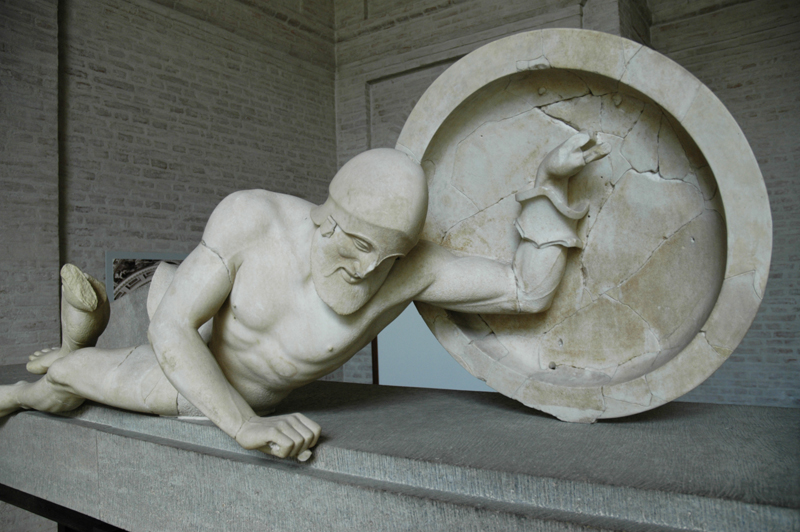
“At the Moulin Rouge” by Henri de Toulouse-Lautrec is one of several works by Toulouse-Lautrec depicting the Moulin Rouge cabaret built in Paris in 1889. This painting portrays a group of three men and two women sitting around a table situated on the floor of the nightclub. In the background of this group is a self-portrait of Toulouse-Lautrec himself, who can be identified as the shorter stunted figure next to his taller companion.
In the right foreground, sitting at a different table is the profile of a dancer, with her face lit in a distinctive light. In the background on the right are a Moulin Rouge dancer and another woman. All the people whose faces are visible have been identified as regular patrons of the Moulin Rouge and acquaintances of the Toulouse-Lautrec.
Toulouse-Lautrec memorialized Parisian nightlife at the end of the nineteenth century with multiple paintings, and the Moulin Rouge, which was a cabaret in Paris, France, was one of his favorites.
At the Moulin Rouge
- Title: At the Moulin Rouge
- French: Au Moulin Rouge
- Artist: Henri de Toulouse-Lautrec
- Year: 1892/95
- Medium: Oil on canvas
- Dimensions: H: 116 cm (45.55 in). Width: 150 cm (59.04 in).
- Museum: Art Institute of Chicago
~~~

La Goulue arriving at the Moulin Rouge
“La Goulue arriving at the Moulin Rouge” by Henri de Toulouse-Lautrec depicts La Goulue, which was the stage name of Louise Weber (1866 – 1929), a French can-can dancer who was a star of the Moulin Rouge, a famous cabaret in Paris, near Montmartre. La Goulue was the most successful can-can dancer of her time. Weber became known as La Goulue because, as an adolescent, she was known for guzzling cabaret patrons’ drinks while dancing. She also was referred to as the Queen of Montmartre.
She initially worked as a washerwoman until she was discovered. At age 16, she was working with her mother in the laundry, but behind her mother’s back began sneaking off to a dance hall dressed in a customer’s “borrowed” dress. Having achieved both fame and fortune, Weber parted company with the Moulin Rouge in 1895 and strike out on her own.
She invested a considerable amount of money into a show that traveled the country as part of a large fair, but her business venture was a failure. La Goulue disappeared from the public eye and suffering from depression, and she drank heavily. Destitute, La Goulue returned to Montmartre in 1928 where she eked out her living selling peanuts and cigarettes on a street corner near the Moulin Rouge. Few recognized the former Queen of Montmartre, and she died at age 62.
La Goulue arriving at the Moulin Rouge
- Title: La Goulue arriving at the Moulin Rouge
- Alternative: La Goulue Arriving at the Moulin Rouge with Two Women
- Artist: Henri de Toulouse-Lautrec
- Year: 1892
- Medium: Oil on canvas
- Dimensions: 79,4 × 59 cm
- Museum: Museum of Modern Art, NYC – MOMA
~~~

At the Moulin-Rouges, Two Women Waltzing
“At the Moulin-Rouges, Two Women Waltzing” by Henri de Toulouse-Lautrec depicts actual people from the Parisian nightlife at Montmartre at the end of the 19th century. The female clown Cha-U-Kao is one of the women dancing, and the singer Jane Avril is behind her, with her back to the spectator. Toulouse-Lautrec imbued his personal experience in his paintings set at the Moulin-Rouge. Although he was born into an aristocratic family, he identified himself with people from all parts of French society.
The Moulin-Rouge was founded in 1889. At the time of this painting, it was housed in a building, which burned down in 1915. It was close to Montmartre in Paris, with a red windmill on its roof that marks it. Moulin Rouge is best known as the birthplace of the modern form of the can-can dance. Originally introduced as a seductive dance by the courtesans who operated from the site, the can-can dance revue evolved into a kind of entertainment of its own and led to the introduction of cabarets across Europe.
Today, the Moulin Rouge is a tourist attraction, offering musical dance entertainment for visitors from around the world. The club’s decor still contains much of the romance of the end of 19th century France.
At the Moulin-Rouges, Two Women Waltzing
- Title: At the Moulin-Rouges, Two Women Waltzing
- Artist: Henri de Toulouse-Lautrec
- Year: 1892
- Medium: oil on cardboard
- Dimensions: Height: 93 cm (36.6 ″); Width: 80 cm (31.4 ″)
- Museum: National Museum in Prague
~~~

Quadrille at the Moulin Rouge
“Quadrille at the Moulin Rouge” by Henri de Toulouse-Lautrec depicts a woman starting a dance that was fashionable in late 18th- and 19th-century Europe. Usually, it is performed by couples and is related to square dancing. The Moulin Rouge cabaret quickly became a great success because it offered a mixture of unique factors. It had a revolutionary architecture for the auditorium that allowed rapid changes of décor and where everyone could mix.
The festive champagne evenings allowed people to dance and be entertained thanks to amusing acts that changed regularly. A new dance that became more and more popular, the Can-can, where dances danced in rhythm in titillating costumes.
Famous dancers and artists performed at the venue. It was also a place loved by artists, including Toulouse-Lautrec, whose posters and paintings secured rapid and international fame for the Moulin Rouge.
Quadrille at the Moulin Rouge
- Title: Quadrille at the Moulin Rouge
- Français: Au Moulin Rouge: Le départ du quadrille
- Artist: Henri de Toulouse-Lautrec
- Year: 1892
- Medium: oil and gouache on cardboard
- Dimensions: Height: 80 cm (31.4 ″); Width: 60.5 cm (23.8 ″)
- Museum: National Gallery of Art, DC
~~~
Henri de Toulouse-Lautrec
Henri Marie Raymond de Toulouse-Lautrec-Monfa (1864 – 1901), also known as Henri de Toulouse-Lautrec was a French painter, printmaker, caricaturist, and illustrator whose immersion in the colorful and theatrical life of Paris in the late 19th century.
Toulouse-Lautrec was born in the Midi-Pyrénées region of France, where his parents were members of a wealthy and aristocratic family. His mother and father were first cousins, his grandmothers were sisters, and unfortunately, he suffered from congenital health conditions sometimes attributed to a family history of inbreeding. Modern physicians attribute his condition to an unknown genetic disorder, sometimes known as Toulouse-Lautrec Syndrome. His legs ceased to grow so that as an adult, he was extremely short (1.42 m or 4 ft 8 in). He developed an adult-sized torso while retaining his child-sized legs.
Physically unable to take part in many activities, Toulouse-Lautrec immersed himself in the arts from an early age. After initially failing college entrance exams, he passed his second attempt and completed his studies. Later, when he sought independence from his mother, Toulouse-Lautrec was drawn to Montmartre, the area of Paris famous for its bohemian lifestyle and the haunt of artists, writers, and philosophers. Studying art in the heart of Montmartre, it became an area he rarely left over the next 20 years.
When the Moulin Rouge cabaret opened, Toulouse-Lautrec was commissioned to produce a series of posters. Although he had a regular and comfortable income from his family, making banners offered him a living of his own. Other artists looked down on the work, but he ignored them. The cabaret reserved a seat for him and displayed his paintings. Among the well-known works that he painted for the Moulin Rouge and other Parisian nightclubs are depictions of famous singers and dancers.
Unfortunately, Toulouse-Lautrec was mocked for his short stature and physical appearance, which led him to abuse alcohol. In addition to his growing alcoholism, Toulouse-Lautrec also frequented prostitutes. He was fascinated by their lifestyle and incorporated those characters into his paintings. In 1901, at the age of 36, he died from complications due to alcoholism and syphilis.
Toulouse-Lautrec
- Name: Henri Marie Raymond de Toulouse-Lautrec-Monfa
- Born: 1864 – Albi, Tarn, France
- Died: 1901 (aged 36) – Saint-André-du-Bois, France
- Resting place: Cimetière de Verdelais
- Nationality: French
- Movement: Post-Impressionism, Art Nouveau
- Notable Works:
- At the Moulin Rouge, The Dance
- Moulin Rouge Paintings
- At the Moulin Rouge
- La Goulue arriving at the Moulin Rouge
- At the Moulin-Rouges, Two Women Waltzing
- Quadrille at the Moulin Rouge
- Marcelle Lender Dancing the Bolero in “Chilpéric”
Reflections
- What first comes to mind when you think of Toulouse-Lautrec?
- What makes Toulouse-Lautrec unique?
- Was Toulouse-Lautrec a talented and charmingly bohemian or a tragic artist?
- Is Toulouse-Lautrec on your top 5, Post-Impressionist List of Artists?
~~~
“Love is when the desire to be desired takes you so badly that you feel you could die of it.”
– Henri de Toulouse-Lautrec
~~~
Photo Credit: 1) By Henri de Toulouse-Lautrec via Wikimedia Commons 2) Museum of Modern Art [Public domain]
Popular this Week








 Sponsor your Favorite Page
Sponsor your Favorite Page SEARCH Search for: Search Follow UsJoin – The JOM Membership Program
Sponsor a Masterpiece with YOUR NAME CHOICE for $5
Share this:
- Tweet
